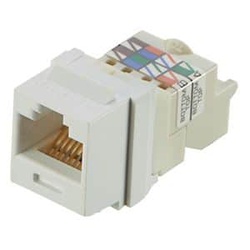
APKR Cat6 Keystone Jack Modules
APKR Cat6 Keystone Jack Modules, also known as Cat6 RJ45 Keystone Jack Modules, are networking components used for terminating Cat6 Ethernet cables within a keystone wall plate, patch panel, or multimedia box. These modules provide a convenient and flexible solution for creating a clean and organized network cabling infrastructure.
- Compatibility: APKR Cat6 Keystone Jack Modules are designed to support Cat6 Ethernet cables, which are capable of transmitting data at speeds up to 10 Gigabit per second (Gbps) over short distances. They are backward compatible with Cat5e and lower category cables.
- Performance: These keystone jack modules are built to meet and exceed the performance standards of Cat6 specifications, ensuring reliable and high-speed data transmission with reduced crosstalk and interference.
- Keystone Design: The modules feature a keystone design, which means they can be snapped into standard keystone wall plates, patch panels, surface mount boxes, or other keystone-compatible outlets. This allows for easy installation and customization of network configurations.
- RJ45 Connector: APKR Cat6 Keystone Jack Modules utilize the standard RJ45 connector interface. This allows for the connection of Cat6 Ethernet cables to establish network connectivity.
| SKU | 1283 |
|---|
Reviews
This product does not have any reviews yet.
Add your reviewDescription
APKR Cat6 Keystone Jack Modules
APKR Cat6 Keystone Jack Modules are modular components used in structured cabling systems to terminate Cat6 Ethernet cables. They are designed to fit into standard keystone wall plates, patch panels, or multimedia boxes, providing a clean and organized solution for network connectivity.
Features
-
Cat6 Compatibility: The APKR Cat6 Keystone Jack Modules are specifically designed for Cat6 Ethernet cables, which are capable of transmitting data at speeds up to 10 Gigabit per second (Gbps) over short distances. These modules ensure reliable and high-speed network connections for data-intensive applications.
-
Keystone Form Factor: The modules follow the keystone form factor, which allows them to snap into keystone-compatible faceplates, patch panels, or multimedia boxes. This design provides flexibility in creating customized network configurations and allows for easy installation and maintenance.
-
RJ-45 Interface: The APKR Cat6 Keystone Jack Modules feature an RJ-45 interface, which is the standard connector used for Ethernet connections. The RJ-45 interface ensures compatibility with a wide range of networking equipment, such as switches, routers, and computers.
-
Toolless Design: These keystone jack modules often come with a toolless design, which means they can be easily terminated without the need for specialized tools. This simplifies the installation process, saves time, and reduces the risk of damaging the cables during termination.
-
Color-Coded Wiring: The modules typically have color-coded wiring labels or schemes that help ensure proper termination. Following the color-coding standards (usually T568A or T568B), you can easily match and connect the individual wires of the Cat6 cable to the appropriate terminals of the keystone jack module.
-
IDC (Insulation Displacement Connection) Terminals: Inside the module, you will find IDC terminals that make the electrical connection between the wires and the jack. The IDC terminals pierce through the insulation of the wires, establishing a reliable electrical connection without the need for stripping or soldering.
-
Shielded or Unshielded: APKR Cat6 Keystone Jack Modules are available in both shielded (STP) and unshielded (UTP) versions. Shielded modules offer additional protection against electromagnetic interference (EMI) and crosstalk, making them suitable for environments with high EMI or where enhanced performance is required.
Overall, APKR Cat6 Keystone Jack Modules provide a convenient and standardized solution for terminating Cat6 Ethernet cables. They offer reliable performance, easy installation, and flexibility in network setups, making them a popular choice for structured cabling systems in residential, commercial, and industrial applications.

